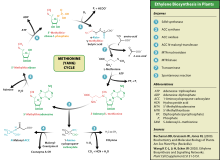更年性水果


更年性水果(英语:climacteric fruit),又称更性水果、后熟型水果,泛指熟成的过程中经历呼吸跃变(respiratory climacteric)的水果。
机制[编辑]
水果可依熟成的过程分为更年性水果与非更年性水果两大类。前者成熟过程中,呼吸作用的速率与乙烯的产生量会突然上升,形成一高峰(即呼吸跃变),再下降回原本的数值[1];后者则无此现象,其呼吸作用速率一般较慢,且随成熟过程缓慢下降,产生的乙烯量也很少。乙烯可以刺激更年性水果中的许多生化反应进行,使水果变软、产生香气,并将贮存的淀粉分解成糖分,且因更年性水果有以自催化反应合成乙烯的途径,也可促进周围的其他更年性水果熟成。更年性水果被采下后仍可继续熟成过程,施予乙烯可以加速其熟成,而非更年性水果从植株上被摘除后熟成即告中断,无法再继续熟成[2],且对其施予乙烯也不能促进其熟成,只能加速其老化过程,如黄化、产生异味、对感染的抗性降低等[3]。
有研究将香瓜合成乙烯的途径抑制后,发现仍有一定程度的果肉软化、变色与糖分增加等熟成的现象发生,显示更年性水果熟成的过程中,除了乙烯介导的反应外,亦有不依赖乙烯的反应途径[4]。
乙烯的合成[编辑]

更年性水果有系统I与系统II两种合成乙烯的模式,其中系统I为自抑制反应(autoinhibitory),意即乙烯可抑制自身的合成,此系统产生的乙烯量较少;系统II则为自催化反应,意即乙烯可促进自身的合成,因此产生的乙烯量较多。平时植物的营养组织即会以系统I合成少量乙烯,在更年性水果熟成的过程中,乙烯的合成会从系统I转为系统II,使乙烯的含量大量上升,造成呼吸跃变的现象,非更年性水果则没有此现象,仅以系统I合成乙烯[5][6]。
植物合成乙烯的前驱物为甲硫胺酸,其转为S-腺苷甲硫氨酸后,可由ACC合成酶(ACS)转为1-氨基环丙烷-1-羧酸(ACC)与甲硫腺苷(5'-methylthioadenosine),前者再经ACC氧化酶(ACO)作用即可产生乙烯,后者则可透过杨氏循环转变回甲硫胺酸[5]。ACC合成酶与ACC氧化酶皆分别由一个基因家族的许多基因编码,且系统I与系统II中,两种酵素各基因的表现量有所不同[4][5],以番茄为模式生物的研究显示系统I仰赖的ACC合成酶主要为ACS1A与ACS6,两者均会被乙烯所抑制;系统II则仰赖ACS2与ACS4,乙烯可刺激两者的活性,形成正回馈的自催化反应。另外系统II中ACC氧化酶的表现量亦高于系统I[6][7]。
实例[编辑]
常见水果中,苹果、香蕉、桃子、杏子、李子、芒果、柿子、木瓜、西瓜、番茄、蓝莓、百香果、奇异果、梨、酪梨、无花果、释迦与榴莲属于更年性水果;草莓、葡萄、黑莓、樱桃、覆盆子、橘子、柠檬、葡萄柚、凤梨、荔枝、石榴与腰果等则属非更年性水果[1][2][8]。香瓜则更年性与非更年性的品系皆有[9]。
研究历史[编辑]
1925年,英国剑桥低温研究站(Low Temperature Research Station)的研究员富兰克林·基德(Franklin Kidd)与查尔斯·韦斯特(Charles West)观察采收后的苹果熟成的现象,他们量测二氧化碳的浓度,发现苹果的呼吸作用有上升的现象,并将此现象命名为更年性(climacteric)[8][10]。剑桥大学的植物学家弗雷德里克·布莱克曼以两人的研究为基础,开启了此领域的相关研究[11]。
参考资料[编辑]
- ^ 1.0 1.1 Alexander, L.; Grierson, D. Ethylene biosynthesis and action in tomato: a model for climacteric fruit ripening. Journal of Experimental Botany. 2002, 53 (377): 2039–2055 [2019-03-20]. PMID 12324528. doi:10.1093/jxb/erf072. (原始内容存档于2016-07-31).
- ^ 2.0 2.1 K. P. Sudheer, V. Indira. Post Harvest Technology of Horticultural Crops. New India Publishing. 2007: 32 [2019-03-20]. ISBN 818942243X. (原始内容存档于2019-03-24).
- ^ D. Arthey, P.R. Ashurst. Storage, Ripening, and Handling of Fruit. Fruit Processing. Springer Science & Business Media. 2012: 41 [2019-03-20]. ISBN 1461521033. (原始内容存档于2019-03-24).
- ^ 4.0 4.1 Eng Chong Pua, Michael R. Davey. Plant Developmental Biology - Biotechnological Perspectives 1. Springer. 2009: 322 [2019-03-21]. ISBN 3642023010. (原始内容存档于2019-03-24).
- ^ 5.0 5.1 5.2 Bram Van de Poel, Inge Bulens, Aikaterina Markoula, Maarten L.A.T.M. Hertog, Rozemarijn Dreesen, Markus Wirtz, Sandy Vandoninck, Yasmin Oppermann, Johan Keulemans, Ruediger Hell, Etienne Waelkens, Maurice P. De Proft, Margret Sauter, Bart M. Nicolai, and Annemie H. Geeraerd. Targeted Systems Biology Profiling of Tomato Fruit Reveals Coordination of the Yang Cycle and a Distinct Regulation of Ethylene Biosynthesis during Postclimacteric Ripening. Plant Physiology. 2012, 160: 1498-1514. doi:10.1104/pp.112.206086.
- ^ 6.0 6.1 Mingchun Liu, Julien Pirrello, Christian Chervin, Jean-Paul Roustan, and Mondher Bouzayen. Ethylene Control of Fruit Ripening: Revisiting the Complex Network of Transcriptional Regulation. Plant Physiology. 2015, 169 (4): 2380–2390. doi:10.1104/pp.15.01361.
- ^ Cornelius S. Barry, M. Immaculada Llop-Tous, Donald Grierson. The Regulation of 1-Aminocyclopropane-1-Carboxylic Acid Synthase Gene Expression during the Transition from System-1 to System-2 Ethylene Synthesis in Tomato. Plant Physiology. 2000, 123 (3). doi:10.1104/pp.123.3.979.
- ^ 8.0 8.1 Anthony Keith Thompson. Fruit ripening conditions. Fruit and Vegetables: Harvesting, Handling and Storage. John Wiley & Sons. 2008: 86 [2019-03-24]. ISBN 1405147806. (原始内容存档于2019-03-24).
- ^ J. C. Pech, M. Bouzayen, A. Latché. Climacteric fruit ripening: Ethylene-dependent and independent regulation of ripening pathways in melon fruit. Plant Science. 2008, 175 (1-2): 114-120. doi:10.1016/j.plantsci.2008.01.003.
- ^ F Kidd, C West. The course of respiratory activity throughout the life of an apple. Report of the Food Investigation Board for the Year 1924. 1925: 27-33.
- ^ George G.Laties. Franklin Kidd, Charles West and F.F. Blackman: The start of modern postharvest physiology. Postharvest Biology and Technology. 1995, 5 (1-2): 1-10. doi:10.1016/0925-5214(94)00009-H.
